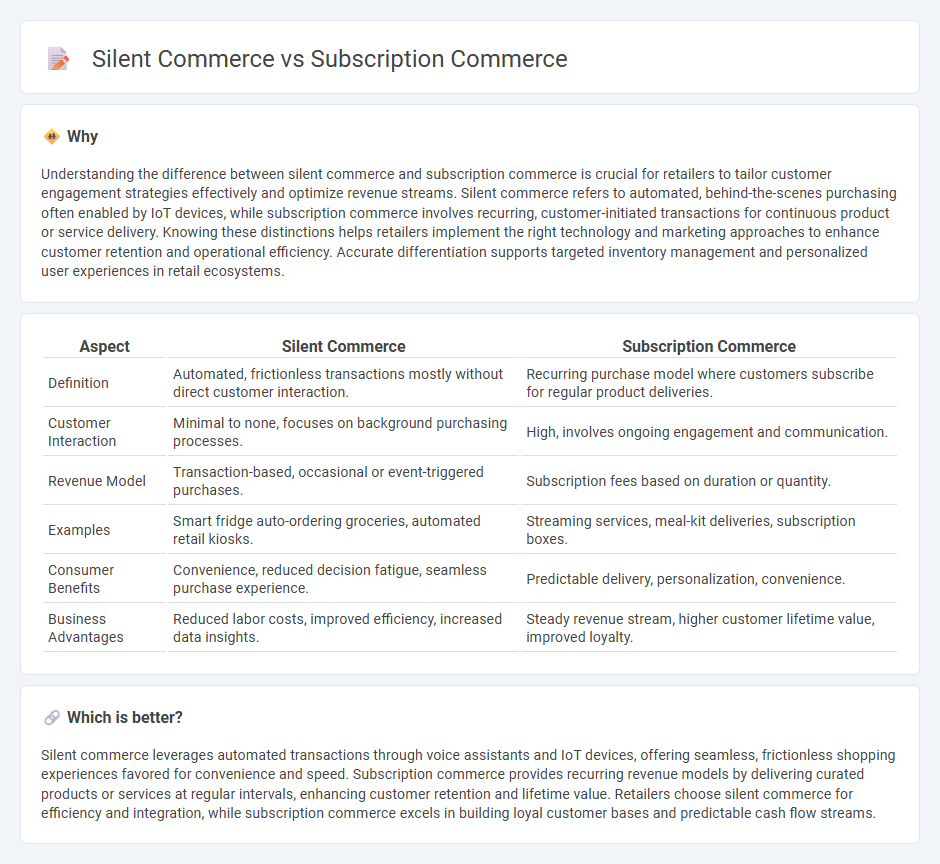
Silent commerce revolves around automated, frictionless purchasing experiences using AI and IoT, enabling seamless transactions without direct customer interaction. Subscription commerce focuses on recurring delivery of products or services, fostering customer loyalty and predictable revenue streams through personalized subscription plans. Discover how these innovative retail models are transforming consumer behavior and business strategies.
Why it is important
Understanding the difference between silent commerce and subscription commerce is crucial for retailers to tailor customer engagement strategies effectively and optimize revenue streams. Silent commerce refers to automated, behind-the-scenes purchasing often enabled by IoT devices, while subscription commerce involves recurring, customer-initiated transactions for continuous product or service delivery. Knowing these distinctions helps retailers implement the right technology and marketing approaches to enhance customer retention and operational efficiency. Accurate differentiation supports targeted inventory management and personalized user experiences in retail ecosystems.
Comparison Table
| Aspect | Silent Commerce | Subscription Commerce |
|---|---|---|
| Definition | Automated, frictionless transactions mostly without direct customer interaction. | Recurring purchase model where customers subscribe for regular product deliveries. |
| Customer Interaction | Minimal to none, focuses on background purchasing processes. | High, involves ongoing engagement and communication. |
| Revenue Model | Transaction-based, occasional or event-triggered purchases. | Subscription fees based on duration or quantity. |
| Examples | Smart fridge auto-ordering groceries, automated retail kiosks. | Streaming services, meal-kit deliveries, subscription boxes. |
| Consumer Benefits | Convenience, reduced decision fatigue, seamless purchase experience. | Predictable delivery, personalization, convenience. |
| Business Advantages | Reduced labor costs, improved efficiency, increased data insights. | Steady revenue stream, higher customer lifetime value, improved loyalty. |
Which is better?
Silent commerce leverages automated transactions through voice assistants and IoT devices, offering seamless, frictionless shopping experiences favored for convenience and speed. Subscription commerce provides recurring revenue models by delivering curated products or services at regular intervals, enhancing customer retention and lifetime value. Retailers choose silent commerce for efficiency and integration, while subscription commerce excels in building loyal customer bases and predictable cash flow streams.
Connection
Silent commerce and subscription commerce intersect through automated, recurring purchase models that enhance customer convenience and streamline transactions. Silent commerce leverages IoT devices and AI to trigger seamless buying experiences without active user input, which complements subscription commerce's emphasis on scheduled deliveries of goods or services. Both approaches drive customer loyalty and predictable revenue by minimizing friction in the retail purchasing journey.
Key Terms
Recurring Payments
Subscription commerce centers on businesses offering products or services through scheduled, recurring payments, enabling predictable revenue streams and customer loyalty. Silent commerce integrates recurring payments seamlessly within user experiences, often without explicit checkout steps, enhancing convenience and reducing friction. Explore further to understand how these models optimize customer retention and streamline payment processes.
Autonomous Transactions
Subscription commerce automates recurring purchases by enabling customers to receive products or services at regular intervals without manual reorder, leveraging predictive analytics and seamless payment integrations. Silent commerce advances this concept by facilitating autonomous transactions through connected devices and AI, allowing purchases to occur without explicit customer interaction, often via IoT ecosystems. Explore how these autonomous transaction models are reshaping retail innovation and customer experience by learning more.
Personalization
Subscription commerce offers personalized product or service delivery through recurring plans tailored to customer preferences, enhancing user engagement and retention. Silent commerce leverages discreet, data-driven personalization embedded within seamless transactions, often without explicit customer input, optimizing shopping experiences passively. Explore how these innovative personalization strategies redefine customer interactions and drive loyalty in modern commerce.
Source and External Links
Subscription Commerce Definition and Meaning - Recharge - Subscription commerce is a business model where businesses offer products and services on a recurring basis, providing convenience for consumers and predictable, recurring revenue for businesses.
Subscription Business Model: How and Why It Works (2025) - A subscription business model involves customers paying a recurring fee to receive products or services over time, offering both convenience for customers and predictable revenue growth for companies, including in ecommerce and streaming sectors.
What Is Subscription Commerce: Know Models, Benefits ... - Subscription commerce allows regular product or service delivery for a recurring fee, featuring models like curation and replenishment subscriptions that improve customer loyalty and experience while providing steady revenue for businesses.
 dowidth.com
dowidth.com